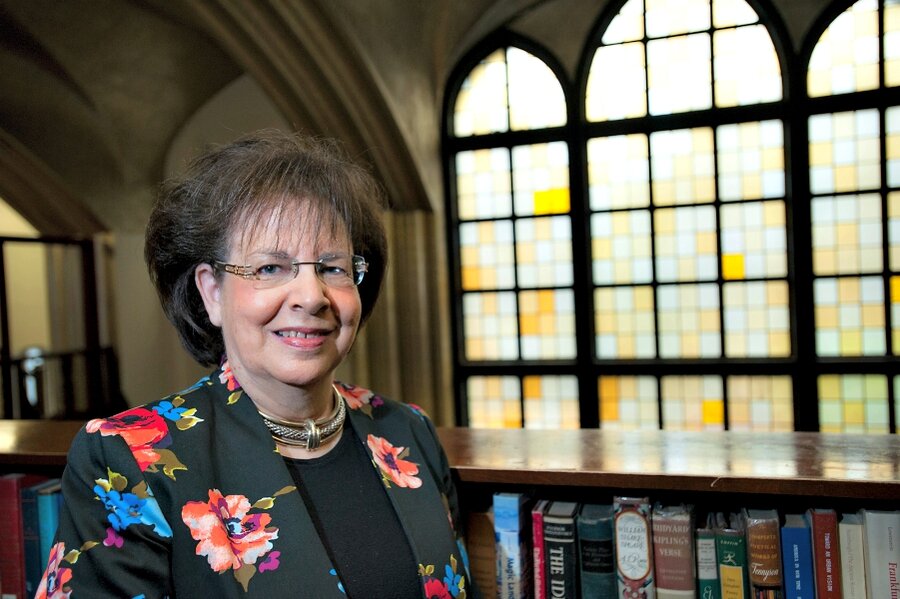Students document the stories of Holocaust survivors
Loading...
| New York
“Whenever there was a selection, everybody was crying ‘Oh, they’re going to kill us tomorrow,’ ” said Frieda Deutscher, a Polish survivor who was on Schindler’s list, looking into the camera. “I said why don’t you think that maybe they will not kill us. I always had a hope and a belief.”
The sole survivor of her village, Mrs. Deutscher died shortly after sharing her story with “Names, Not Numbers,” an oral history project that teaches students about the Holocaust through research, filming, and editing. But more than that, the New York-based Yeshiva University High School program instills participating students with a sense of duty.
“They’re really the last generation that has this honor to sit across from a survivor and ask whatever questions they want. They understand their responsibility and they all rise to the occasion,” says Tova Rosenberg, the project’s director and founder. “They understand this isn’t just taking out their iPhone and asking their grandparents a few questions. The students are making a professional documentary.”
Mrs. Rosenberg, who directs the Hebrew Language program at both the girls and boys high schools, founded the project 12 years ago.
Participating students, mostly high school seniors, work with professionals, including local newspaper editors, filmmakers, and Jewish studies teachers.
Ultimately, their 60-to 90 minute documentaries become a permanent part of Jewish institutions worldwide including the National Library of Israel, the Yad Vashem center for Holocaust research, and Yeshiva University’s Gottesman Library. Several holocaust museums, including those in Skokie, Ill., Houston, and Toronto, also archive the films.
To date, 850 survivors and World War II veterans have recorded their testimonies.
For some, it’s the first time they’ve shared their experiences.
Telling their stories can be cathartic, says Leila Levinson, author of the 2011 book “Gated Grief: The Daughter of a GI Camp Liberator Discovers a Legacy of Trauma.”
“Time is so finite now, and as they get older their defenses break down, and they want to tell their story,” Ms. Levinson says. “They [the interviewers] become a medium for them to tell their stories.”
The name of the project, “Names, Not Numbers,” reflects the idea that each person experienced the Holocaust individually. It helps reclaim lost identities: The Nazis tattooed numbers on inmates’ arms and affixed badges and serial numbers on uniforms to erase the identity of Jewish people in the concentration camps.
“If you think about it, they are not just saying their names during the interviews, they are telling the names of their parents, their siblings. They’re giving an identity to the number. It’s the reverse of what the Nazis did,” Rosenberg says.
In the weeks before the actual recording students hone their interviewing skills. They learn when to let the interviewee get little lost in thought and when to gently nudge someone back on track. They learn how to take survivors back in time through various questions about life before the war – about how the Sabbath table was set and how the different dishes smelled. And they learn to listen to how the survivors and liberators reestablished themselves after the war.
“They learn that you have to overcome some discomfort when you’re asking questions. They learn to use their questions to trigger a fresh perspective and break new ground,” says Dr. Michael Berenbaum, former project director of the US Holocaust Memorial Museum and former president and CEO of the Survivors of the Shoah Visual History Foundation (now the USC Shoah Foundation). Dr. Berenbaum speaks to students twice a year on interviewing techniques.
Sima Fried, now a 20-year-old anthropology major at Stern College for Women at Yeshiva University, remembers her interview with Luba Abromovitch. She recalls being nervous about asking someone to relive and reveal a painful period.
“One of the things that struck me about Luba Abromovitch was her determination. She never gave up and always pushed herself to make a difference,” Ms. Fried says. “Luba’s message to us was 'Remember it … Remember it' and that we have to be prepared to actively fight the evil in today’s world. 'Never forget' is not enough. We must actively work, in our own ways, to make a better future.”
Fried says her involvement in the project led her to work as a docent at the Simon Wiesenthal Center’s Museum of Tolerance in Los Angeles. She leads groups of young students through discussions on the power of words and images, and the effects of stereotyping, prejudice, and racism.
Students also interview second-generation survivors and veterans.
Rabbi Jacob J. Schacter, who teaches at Yeshiva University, shared the story of his father, Rabbi Herschel Schacter, who as part of Gen. George S. Patton’s Third Army was the first Jewish chaplain to enter Buchenwald concentration camp on April 11, 1945.
Mr. Schacter says his participation, as well as the participation of others in the program, fulfilled three important roles.
“One, it honors the victims, whose only wish was to be remembered. Two, it shows the survivors who lived through inexplicable horror that there is life and there is joy and there is family on the other side,” Schacter says. “Three, it gives the students a chance to be inspired and come face to face with people who were bona fide heroes.”







